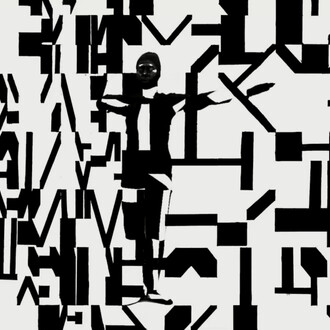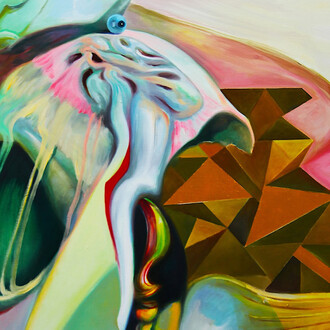bitforms gallery is pleased to announce Rafael Lozano-Hemmer’s seventh solo exhibition, presented in tandem with the artist’s solo display at The Armory Show. A statement from the artist’s studio serves as the press release for this exhibition.
Prenez un cercle, caressez-le, il deviendra vicieux !
[Describe a circle, stroke its back and it turns vicious].
(Eugène Ionesco)
Aquí comienza el campo inexplorado
Redondo a causa de los ojos que lo miran[Here begins the unexplored territory
Round on account of the eyes that behold it](Vicente Huidobro)
How to orient in these times? How to position ourselves — individually, yet always in relation to one another — amid the moment’s perpetually shifting terrains? When the topologies of our lives — the contours of where and how and with whom we exist — are flattened into extractable packets of data and reduced to nothing more than coordinates upon some grid, what becomes a horizon? “Here,” as Huidobro writes, “begins the unexplored territory”.
Caressing the circle roams the perimeter of such questions, at moments traversing them, negotiating a singular throughline, and, at others, tacking away toward uncharted ground. Through computer sensors and cameras in the round, the works on view have a panoramic experience of the public, not the other way around. The exhibition’s five artworks experiment with co-presence, modes of detection, and the interplay of translucency and transparency. Here, bodies and their shadows, architectures and their atmospherics all merge and move together in fluid dynamics. Presence generates perspective; or, as Duchamp put it, “The spectator makes the picture.” The sense of partiality permeates each piece, with a built-in instability that results in a transitional presence, always becoming something else.
Shadow tuner is a new interactive artwork, first presented on a huge spherical balloon as a public art installation in Abu Dhabi. The piece is a digital globe that links to thousands of geo-located radio stations that playback when a visitor is in front of them. Like the artist's pioneering installation Frequency and volume (2003), the body of the visitor becomes the antenna or tuning dial to scan for sound signals, only instead of scanning the local radioelectric spectrum, Shadow tuner offers a global polyphony of live streams. The piece has a built-in AI analyzer so that spoken word content gets priority over music, thereby highlighting world language diversity.
Next, Standards and double standards, Subsculpture 3 consists of a single fastened belt suspended at waist height from a stepper motor on the ceiling. Controlled by a computerized tracking system, the belt rotates automatically to follow the public, turning its buckle slowly to “face” each passer-by. The piece creates a "material absence", using the belt as a fetish of paternal authority, asking questions that Lozano-Hemmer's work has been posing for three decades: who is the observer and who is the observed? how can an absence be made tangible? and, where are the authorities?
Cardinal directions is a kinetic sculpture consisting of a surveillance monitor that displays an extract of Huidobro’s poem Altazor (1919-1931). Referring to the geography of his native Chile, Huidobro wrote: “The four cardinal directions are three: North and South.” When a presence is detected by infrared sensors, the monitor starts to rotate. As the poem is “geolocated” it always aligns itself to the earth's cardinal points, and the public must walk around the piece in order to read it, like a periscope.
Premiering at bitforms gallery, Transparency display is a stand-alone interactive glass triptych that reveals and conceals participants in real-time using the transparency and translucency of liquid crystal pixels embedded in glass panels. The piece is an architectural screen that is translucent by default, impeding the public to see through it; when a visitor is detected by an on-board computer vision camera, the piece automatically "opens up" a region of the display, like a digital shadow, that is fully transparent, creating an aperture. Through these fleeting "portals" a visitor on one side can see visitors on the other, creating an uncanny and ever-changing line of sight between them. Inspired by Dan Graham's reflective and refractive glass pavilions, Kit Galloway and Sherrie Rabinowitz's Hole in the wall performance, and Lozano-Hemmer's own installations that overlap participants' shadows, such as Body movies (2001), the work converts an architectural subdivision into a connective switchboard for eye contact, shadow play, and sous- and sur-veillance. The piece is made with the artist studio's own "pixel glass" technology, which is a variation of traditional "smart glass" treatments, but pixel-addressable and dimmable.
Finally, Recurrent Lloyd Wright is a recursive algorithmic animation that draws together the vast corpus of Frank Lloyd Wright’s Usonian architectural blueprints and evaporates them into a fluid atmosphere. In this piece, the modernist utopian vision of Lloyd Wright’s designs drift back and forth, and are endlessly remade. The sense of context and materials at the core of the architect’s poetics is dissolved into a virtual and speculative existence. In rendering atmospheric Lloyd Wright’s grounded design, Recurrent Lloyd Wright is, at once, a commentary on the fate of modernism and a blueprint to imagine future, possible architectonics.
(Text by Rafael Lozano-Hemmer)
















